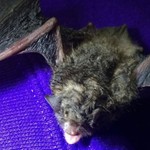
Photo: Daniel Lindner, az USDA ForestService
10-10-2019 - From your home’s floor to its rafters, forest products are embedded in daily life. In recognition of the many ways we use and value wood, our October web feature spotlights research related to timber.
Our stories include a scientist interested in the aesthetic value and market potential of different wood, research on getting the most out of small logs, a product that helps forest managers plan for changes in climate and a partnership that enables states to account for trees harvested and timber produced.
2018 Research Highlights
Lethal Fungus that Causes White-nose Syndrome May Have an Achilles` Heel
Since it was discovered in New York State in 2006, white-nose syndrome has killed millions of bats and may have spread as far west as Washington State. But Northern Research Station scientists discovered that the fungus behind white-nose syndrome may have an Achilles' heel: ultraviolet light.
White-nose syndrome has spread steadily for the past decade and is caused by the fungus Pseudogymnoascus destructans, known as P. destructans. The fungus infects bats during hibernation, but treating bats for the disease during hibernation is extremely challenging, so any weakness of P. destructans is good news to managers. In the course of genomic analyses of P. destructans, a team of scientists from the Northern Research Station and the University of New Hampshire found that the fungus is highly sensitive to ultraviolet (UV) light. With collaborators from Bucknell University and the Wisconsin Department of Natural Resources, researchers started a treatment trial to see if UV light could work on naturally infected bats. Forty-five little brown bats were collected from a site in Wisconsin and transported to Bucknell in late December of 2017; 15 bats were treated with a low dose of UV light, 15 were treated with a "high" dose (about 10 times the low dose), and 15 bats were left untreated. Preliminary results indicate that UV-treated bats had less of the fungal pathogen compared to untreated bats up to 15 weeks after treatment, and no negative treatment effects were observed. More work is needed to determine if UV light treatment will result in increased survival rates, but the hope is that treatment will enable more bats to survive hibernation.



